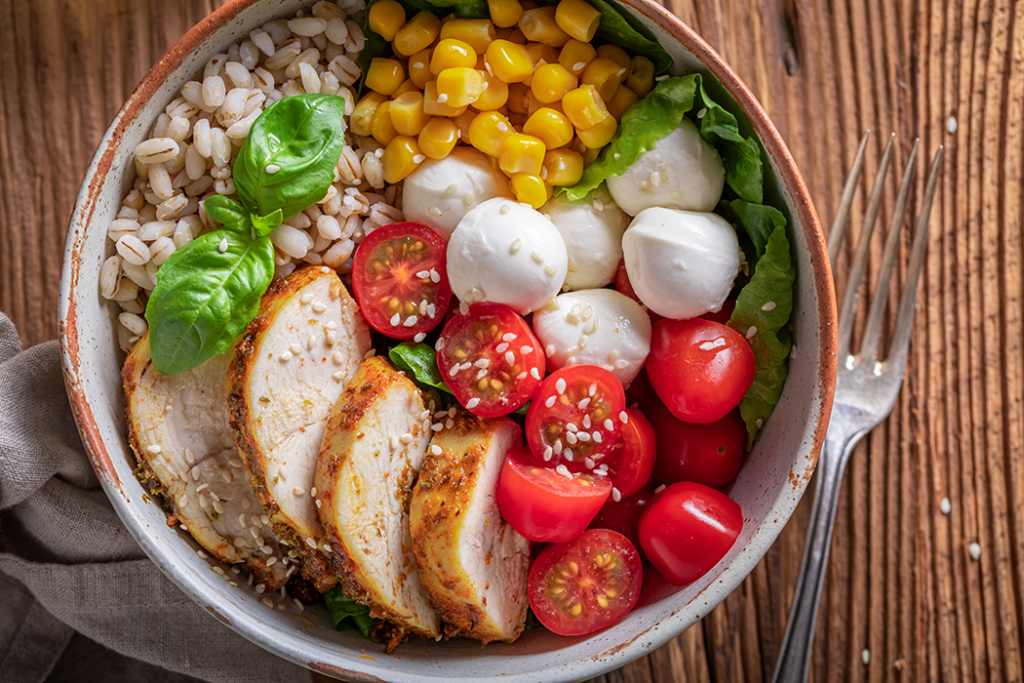The mistake you’re making that’s not helping you lose weight

Written by Michelle Jaelin, Registered Dietitian
January is when I receive the greatest number of inquiries for help with weight loss or eating heathier as a registered dietitian. And after years of practice, I’ve noticed what makes some people more successful at their goals than others.
But there’s one common bad habit you might be making that’s preventing you from reaching your goals. Here is my #1 tip to help you achieve your healthy eating or weight loss goals this year.
Eat Enough
You must eat enough. I know it sounds counterintuitive, because the most common message people hear when it comes to weight loss is: Move more, eat less. And while this statement may be scientifically correct, if it actually worked wouldn’t more people be successful? If you’re someone whose had the lifelong struggle of trying to lose weight, you are not alone.
Most diets focus on restriction, strict meal plans and eating the exact same meals every day to maintain caloric control. A common problem with eating less, especially at breakfast and lunch when you’re trying to lose weight, is you’re not fueling properly for the rest of the day. This is why you might find yourself having extra portions during dinner, or raiding the pantry at night looking for snacks – that lead to overeating. Does this sound familiar?
Blood Sugar and Weight Loss
When you eat, food is broken down into glucose (sugar) and your blood sugar rises. Your pancreas releases insulin, the hormone that takes the glucose from your blood to your cells for energy. Extra glucose is stored as glycogen in your muscles and liver. If you are eating more calories than your body needs, your body will store it as fat. Especially if you are eating too much later in the day when you are more sedentary, ie. sitting on the couch.
But Aren’t Grains Bad for Blood Sugar?
The truth is, all carbohydrates will cause blood sugar levels to rise. The key is choosing carbs that don’t cause that blood sugar spike. This is where whole grains can help. Whole grains are made of three parts: The outer bran layer, where there’s most of the fibre, the germ layer, which houses the nutrients, healthy fats and antioxidants and the endosperm that contains the starch. The soluble fibre in the bran is what slows down digestion of a whole grain so it’s absorbed less quickly from the gut. Therefore, when you consume whole grains, you don’t get that spike in blood sugar, but rather a gradual increase because of the nutritional benefits. This is good for your blood sugar!
Change your Mindset
You need to drop the idea that eating less = better. Often when people are on a “diet” and calorie restricting, they find themselves thinking about food all the time. This is a sign you need eat more. Hungry people don’t meet their wellness goals, satisfied people do. Build balanced meals that keep you full so you don’t find yourself thinking about food between meals.
How to Eat MORE
The trick is to feel as full as you can while still eating in a small calorie deficit, so you get results. People love it when I tell them they need to add more to their diet, not take away from it. Here’s where to start:
- Balance every meal with fibre, protein and fat. These three nutrients keep you full longer because they digest slower. Find them in foods like whole wheat bread, oats, vegetables, fruits, dairy, tofu, which is made from local Ontario soybeans, and animal proteins. Make sure to eat every 3-4 hours. This will keep you energized and allow your body to burn fat throughout the day.
- Don’t be afraid of carbs. The best carbs for healthy eating and weight loss are whole grains: Whole wheat products like bread and pasta, barley, and oats are fantastic for weight loss because they are high in fibre, b-vitamins, iron and keep you full longer. You would also be surprised at how much more energy you have by keeping carbs in your diet. And that include energy to complete tough workouts and play sports!
- For breakfast, have overnight oats made the night before. The added wheat bran in this recipe adds more fibre and minerals to keep you full. Add ½ cup soy yogurt for additional protein to keep you satisfied all throughout the morning.
- For satisfying snacks, I always recommend balancing carbohydrates with protein to give you that boost of slow burning energy to get you through to the next meal. Great snack ideas that combine carbs with protein are soy hummus with a few whole grain crackers, ants on a log (perfect for kids) or one of these Canadian granola bars.
- At lunch time, make ¼ of your plate whole grains. The rest of the plate can be balanced with ¼ plate protein, like tofu or animal proteins like chicken, beef, pork or fish. As a Chinese dietitian, I’m a huge fan of tofu for its nutritional benefits and versatility. Find hunger satisfying tofu recipes on Good in Every Grain’s recipe database here. Half your plate should be vegetables. Dinner can be similar to lunch, with a balanced plate of protein, fibre from whole grains, vegetables and a small amount of healthy fats from cooking oils, nuts, seeds or avocados.
Listen to your Body and Nourish!
While restrictive dieting tells you to follow strict food rules or weigh/measure out your food, eating healthy means eating intuitively and with balance. It means knowing that on days you do a tough workout, have more stress, or are going through your menstrual cycle you will eat more calories – and that’s perfectly normal. It’s also about allowing yourself to balance healthy eating with richer, more satisfying treats. This includes the occasional slice of chocolate cake or going through the drive thru for that satisfying bacon cheeseburger with French fries!
Michelle Jaelin is TV and digital media Nutrition Expert, registered dietitian, content creator and communications & marketing consultant who resides in Hamilton, ON. Find more deliciously diverse and nutritious food content on @michellejaelin on Instagram, TikTok and YouTube.



